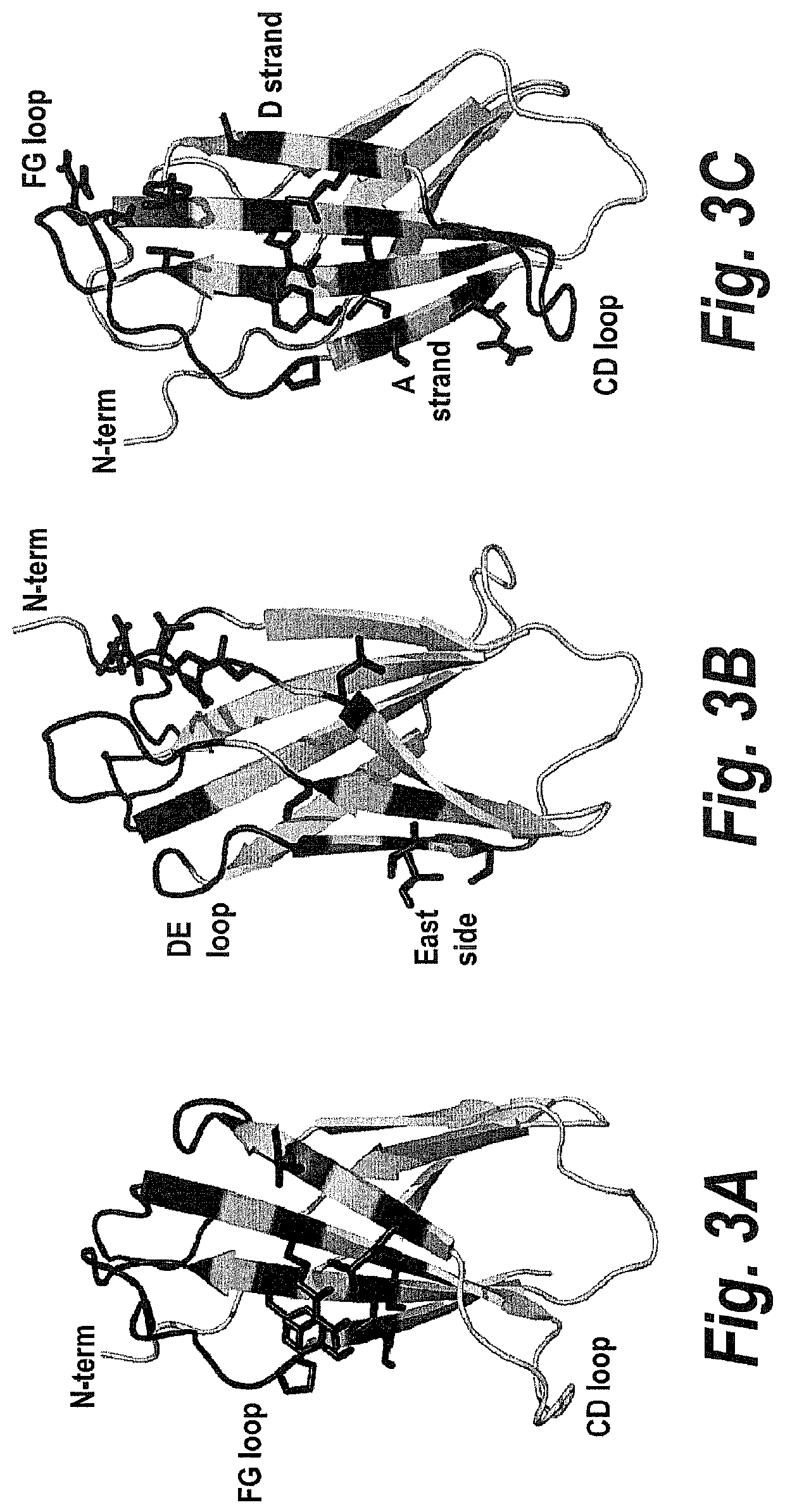Fibronectin based scaffold proteins
a scaffold protein and fibronectin technology, applied in the field of fibronectin based scaffold proteins, can solve the problems of reducing the efficacy of protein therapeutics and potentially harmful immune responses in patients
- Summary
- Abstract
- Description
- Claims
- Application Information
AI Technical Summary
Benefits of technology
Problems solved by technology
Method used
Image
Examples
example 1
n and Purification of Fibronectin Based Scaffold Proteins
[0309]Selected binders were cloned into a PET9d vector and transformed into E. coli BL21 DE3 plysS cells. Transformed cells were inoculated in 5 ml LB medium containing 50 μg / mL kanamycin and 34 μg / ml chloramphenicol in a 24-well format and grown at 37° C. overnight (inoculums culture). Production cultures were established by aspirating 200 μl of the inoculum culture into 5 ml (in a 24-well format) of TB-Overnight Expression Media (auto induction) containing 50 μg / ml Kanamycin and 34 μg / ml chloramphenicol. The cultures were grown at 37° C. for 4 hours at which time the temperature was lowered to 18° C. and grown for 20 hours. Cultures were harvested by centrifugation for 10 minutes at 2750 g at 4° C.
[0310]Cell pellets (in 24-well format) were lysed by resuspension in 450 μl of Lysis buffer (50 mM NaH2PO4, 0.5 M NaCl, 1× Complete™ Protease Inhibitor Cocktail-EDTA free (Roche), 1 mM PMSF, 10 mM CHAPS, 40 mM Imidazole, 1 mg / ml ly...
example 3
n of West Side Binders
[0325]Libraries of West Side (“WS”) binder polypeptides comprising a modified 10Fn3 domain were screened using mRNA display (Xu et al Chem Biol. 2002 August; 9(8):933-42) for binding to murine IL-17, murine DLL4 or human PXR as targets. The WS binders were designed such that the BC loop sequence was left as wildtype. The WS1 library design (see FIG. 9A) was used to identify binders to the target human PXR and the WS-LI1 library design (see FIG. 9A) was used to identify binders to the targets murine IL-17 or murine DLL4. Target binding was monitored by qPCR and populations were cloned and expressed in E. coli when a specific binding signal was observed.
example 4
n of DLL4 and Notch 1 Interaction by WS-LI1 Binders Capable of Binding Murine DLL4
[0326]DLL4 is a ligand for the Notch 1 protein. The ability of 10Fn3 polypeptides having the WS-LI1 design to disrupt the interaction between Notch 1 and murine DLL4 was assessed by employing a competitive Biacore experiment. Approximately 4500 RU of Notch1-Fc was immobilized on a CM5 Biacore chip. 2 μM of WS-LI1 binders were equilibrated with 20 nM murine DLL4 in HBSP buffer and 5 mM CaCl2 along with a control in which no polypeptide was added. Each sample was flowed over the chip and binding of murine DLL4 was compared to the control in which no WS-LI1 polypeptide was added, so that a reduction in signal corresponded to inhibition of the Notch 1:murine DLL4 interaction. Between each sample run, the chip was regenerated with two 30-second washes in HBSP pH 7.4 and 50 mM EDTA. The results of this experiment are shown in FIG. 5. The polypeptides having the sequence of SEQ ID NO: 3 and 4 were each found ...
PUM
| Property | Measurement | Unit |
|---|---|---|
| concentration | aaaaa | aaaaa |
| molecular mass | aaaaa | aaaaa |
| total molecular mass | aaaaa | aaaaa |
Abstract
Description
Claims
Application Information
 Login to View More
Login to View More - R&D
- Intellectual Property
- Life Sciences
- Materials
- Tech Scout
- Unparalleled Data Quality
- Higher Quality Content
- 60% Fewer Hallucinations
Browse by: Latest US Patents, China's latest patents, Technical Efficacy Thesaurus, Application Domain, Technology Topic, Popular Technical Reports.
© 2025 PatSnap. All rights reserved.Legal|Privacy policy|Modern Slavery Act Transparency Statement|Sitemap|About US| Contact US: help@patsnap.com



